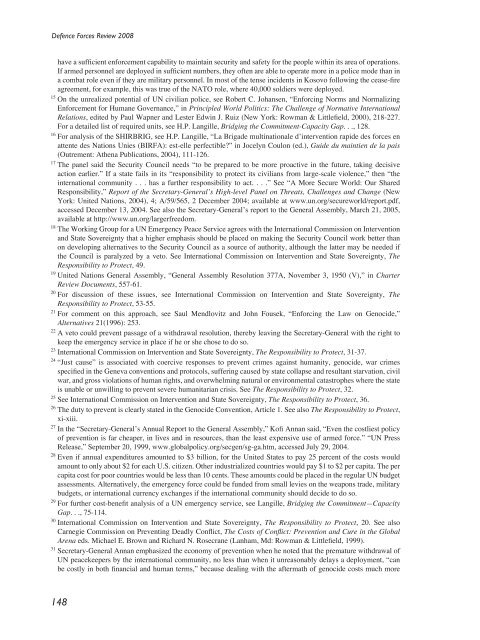Defence Forces Review 2008
Defence Forces Review 2008
Defence Forces Review 2008
You also want an ePaper? Increase the reach of your titles
YUMPU automatically turns print PDFs into web optimized ePapers that Google loves.
<strong>Defence</strong> <strong>Forces</strong> <strong>Review</strong> <strong>2008</strong><br />
have a sufficient enforcement capability to maintain security and safety for the people within its area of operations.<br />
If armed personnel are deployed in sufficient numbers, they often are able to operate more in a police mode than in<br />
a combat role even if they are military personnel. In most of the tense incidents in Kosovo following the cease-fire<br />
agreement, for example, this was true of the NATO role, where 40,000 soldiers were deployed.<br />
15<br />
On the unrealized potential of UN civilian police, see Robert C. Johansen, “Enforcing Norms and Normalizing<br />
Enforcement for Humane Governance,” in Principled World Politics: The Challenge of Normative International<br />
Relations, edited by Paul Wapner and Lester Edwin J. Ruiz (New York: Rowman & Littlefield, 2000), 218-227.<br />
For a detailed list of required units, see H.P. Langille, Bridging the Commitment-Capacity Gap. . ., 128.<br />
16<br />
For analysis of the SHIRBRIG, see H.P. Langille, “La Brigade multinationale d’intervention rapide des forces en<br />
attente des Nations Unies (BIRFA): est-elle perfectible” in Jocelyn Coulon (ed.), Guide du maintien de la pais<br />
(Outrement: Athena Publications, 2004), 111-126.<br />
17<br />
The panel said the Security Council needs “to be prepared to be more proactive in the future, taking decisive<br />
action earlier.” If a state fails in its “responsibility to protect its civilians from large-scale violence,” then “the<br />
international community . . . has a further responsibility to act. . . .” See “A More Secure World: Our Shared<br />
Responsibility,” Report of the Secretary-General’s High-level Panel on Threats, Challenges and Change (New<br />
York: United Nations, 2004), 4; A/59/565, 2 December 2004; available at www.un.org/secureworld/report.pdf,<br />
accessed December 13, 2004. See also the Secretary-General’s report to the General Assembly, March 21, 2005,<br />
available at http://www.un.org/largerfreedom.<br />
18<br />
The Working Group for a UN Emergency Peace Service agrees with the International Commission on Intervention<br />
and State Sovereignty that a higher emphasis should be placed on making the Security Council work better than<br />
on developing alternatives to the Security Council as a source of authority, although the latter may be needed if<br />
the Council is paralyzed by a veto. See International Commission on Intervention and State Sovereignty, The<br />
Responsibility to Protect, 49.<br />
19<br />
United Nations General Assembly, “General Assembly Resolution 377A, November 3, 1950 (V),” in Charter<br />
<strong>Review</strong> Documents, 557-61.<br />
20<br />
For discussion of these issues, see International Commission on Intervention and State Sovereignty, The<br />
Responsibility to Protect, 53-55.<br />
21<br />
For comment on this approach, see Saul Mendlovitz and John Fousek, “Enforcing the Law on Genocide,”<br />
Alternatives 21(1996): 253.<br />
22<br />
A veto could prevent passage of a withdrawal resolution, thereby leaving the Secretary-General with the right to<br />
keep the emergency service in place if he or she chose to do so.<br />
23<br />
International Commission on Intervention and State Sovereignty, The Responsibility to Protect, 31-37.<br />
24<br />
“Just cause” is associated with coercive responses to prevent crimes against humanity, genocide, war crimes<br />
specified in the Geneva conventions and protocols, suffering caused by state collapse and resultant starvation, civil<br />
war, and gross violations of human rights, and overwhelming natural or environmental catastrophes where the state<br />
is unable or unwilling to prevent severe humanitarian crisis. See The Responsibility to Protect, 32.<br />
25<br />
See International Commission on Intervention and State Sovereignty, The Responsibility to Protect, 36.<br />
26<br />
The duty to prevent is clearly stated in the Genocide Convention, Article 1. See also The Responsibility to Protect,<br />
xi-xiii.<br />
27<br />
In the “Secretary-General’s Annual Report to the General Assembly,” Kofi Annan said, “Even the costliest policy<br />
of prevention is far cheaper, in lives and in resources, than the least expensive use of armed force.” “UN Press<br />
Release,” September 20, 1999, www.globalpolicy.org/secgen/sg-ga.htm, accessed July 29, 2004.<br />
28<br />
Even if annual expenditures amounted to $3 billion, for the United States to pay 25 percent of the costs would<br />
amount to only about $2 for each U.S. citizen. Other industrialized countries would pay $1 to $2 per capita. The per<br />
capita cost for poor countries would be less than 10 cents. These amounts could be placed in the regular UN budget<br />
assessments. Alternatively, the emergency force could be funded from small levies on the weapons trade, military<br />
budgets, or international currency exchanges if the international community should decide to do so.<br />
29<br />
For further cost-benefit analysis of a UN emergency service, see Langille, Bridging the Commitment—Capacity<br />
Gap. . ., 75-114.<br />
30<br />
International Commission on Intervention and State Sovereignty, The Responsibility to Protect, 20. See also<br />
Carnegie Commission on Preventing Deadly Conflict, The Costs of Conflict: Prevention and Cure in the Global<br />
Arena eds. Michael E. Brown and Richard N. Rosecrane (Lanham, Md: Rowman & Littlefield, 1999).<br />
31<br />
Secretary-General Annan emphasized the economy of prevention when he noted that the premature withdrawal of<br />
UN peacekeepers by the international community, no less than when it unreasonably delays a deployment, “can<br />
be costly in both financial and human terms,” because dealing with the aftermath of genocide costs much more<br />
148
















